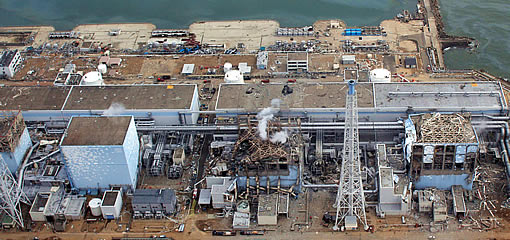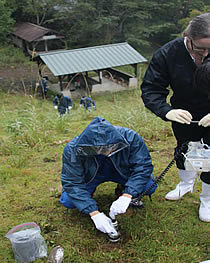 Fukushima Daiichi Nuclear Plant disaster
Fukushima Daiichi Nuclear Plant disaster
(Photo: Air Photo Service Co. Ltd., Japan - Creative Commons 3.0)
UoB Research Team: Professor Lynne Macaskie (School of Bisociences), Dr Joseph Hriljac (school of Chemistry), Dr Stephanie Handley-Sidhu (School of Geography, Earth and Environmental Sciences)
Introduction
Since the 1950s, nuclear weapon and energy programmes have created a legacy of radioactive waste and contamination worldwide.In the UK alone, the safe disposal of legacy nuclear waste will cost £80 billion (est.) and take up to 100 years to complete. Nuclear disasters pose additional challenges.
Research objectives - what was the challenge?

Dr Handley-Sidhu was involved in Environmental monitoring at Iitate Village, Fukushima
The Fukushima Daiichi incident for example, has contaminated a large area of Japan (650 km2) and cleanup is estimated to cost $125 billion. Despite this, as the world’s energy demand increases, and as fossil fuels run out or get phased out due to environmental concerns, the need for nuclear power and, in turn, low cost solutions to its waste clean-up continue to grow.
Research outputs - what was the process?
To address the problem, researchers at the University of Birmingham have been working to translate more than 30 years of research into the development of a low cost solution for nuclear waste clean-up that innovatively employs the use of microbially-generated bio materials. Their recent work in Japan is based upon research findings showing that biologically produced calcium phosphate minerals have higher capacity for waste cleanup than commercially available equivalent materials.
Supported through a Follow on Fund Award with investment from the EPSRC’s Impact Acceleration Account, the research team has worked with partners at the Japan Atomic Energy Agency (JAEA) to test the solution on soil waste water collected from the Fukushima clean-up.
Research impact
Whilst the solution remains in the early stages of development, promising results have led to:
- the JAEA supporting a larger £142,000 Technology Proof of Concept project funded by NERC which aims to further validate the research approach.
- the proposed development of a bid to the EPSRC UK Japan Civil Nuclear Research Programme.
- a new collaboration with Sellafield Ltd (owners of the Sellafield Nuclear Plant in the UK), to examine the potential use of the solution in the clear up of nuclear waste material at the site.
- understanding that with further development, the solution could also be used in the exploitation of rare earth materials that are often discovered embedded into ores associated with nuclear energy (uranium and thorium). This is significant because separating these ores from the rare earths is currently an expensive, complex and risky proposition for the mining industry.
This EPSRC-funded joint UK-Japan proposal on civil nuclear research will focus on several aspects of clean-up of nuclear waste particularly relevant at Fukushima.
Work led by the UK will include the production of novel ion exchange materials designed to be used for magnetically assisted separation and nanomaterials designed to be used in injectable barrier materials to prevent radionuclide migration through, e.g. cracks in structures.
The work led by Japan will include the development of systems that will biomineralise ion exchange materials in saline solution and the use of synchrotron X-ray techniques to characterise all new materials and study how radionuclides bind to them.
Learn More
Learn more about Professor Lynne Macaskie
Learn more about Dr Stephanie Handley-Sidhu
Learn more about the Birmingham Energy Institute (BEI)